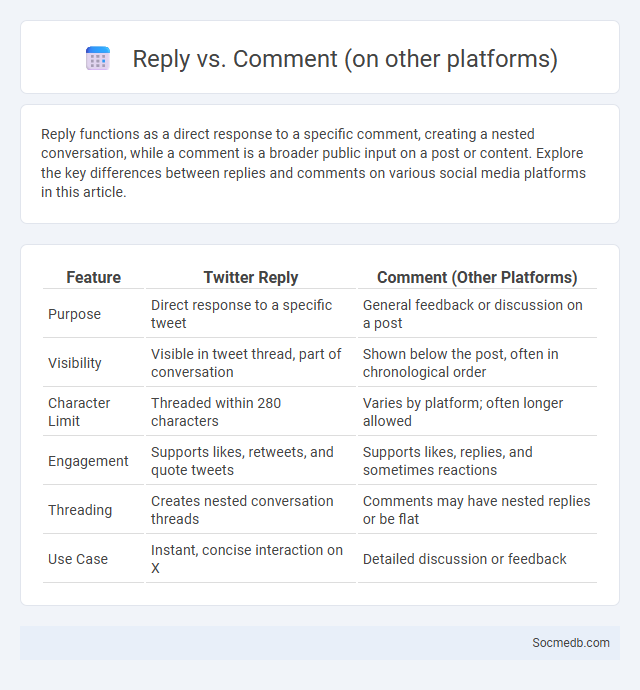
Photo illustration: Reply vs Comment (on other platforms)
Reply functions as a direct response to a specific comment, creating a nested conversation, while a comment is a broader public input on a post or content. Explore the key differences between replies and comments on various social media platforms in this article.
Table of Comparison
| Feature | Twitter Reply | Comment (Other Platforms) |
|---|---|---|
| Purpose | Direct response to a specific tweet | General feedback or discussion on a post |
| Visibility | Visible in tweet thread, part of conversation | Shown below the post, often in chronological order |
| Character Limit | Threaded within 280 characters | Varies by platform; often longer allowed |
| Engagement | Supports likes, retweets, and quote tweets | Supports likes, replies, and sometimes reactions |
| Threading | Creates nested conversation threads | Comments may have nested replies or be flat |
| Use Case | Instant, concise interaction on X | Detailed discussion or feedback |
Understanding Replies and Comments: Definitions
Replies and comments are interactive elements on social media platforms that facilitate user engagement by allowing individuals to respond directly to posts or other users. Comments serve as general feedback or opinions under the original content, while replies are nested responses targeting specific comments, creating threaded conversations. Understanding these distinctions enhances communication clarity and improves the management of online interactions across platforms like Facebook, Twitter, and Instagram.
Key Differences Between Replies and Comments
Replies on social media are direct responses to specific comments, creating threaded conversations that enhance user interaction and clarity. Comments generally appear as broader feedback or opinions on the original post, without necessarily linking to other individual replies. Understanding these distinctions helps you navigate discussions more effectively, fostering meaningful engagement within your online community.
Platform-Specific Usage: Replies vs Comments
Replies on platforms like Twitter and Instagram serve direct, conversational purposes by targeting specific users, enhancing engagement through real-time interaction. Comments on Facebook or LinkedIn foster broader discussions, allowing users to share opinions and feedback on posts, thus increasing content visibility and community building. Understanding these platform-specific nuances improves social media strategies by tailoring communication styles for maximum audience impact.
Social Media Interactions: When to Reply or Comment
Social media interactions thrive on timely and relevant replies or comments that foster engagement and build community trust. Brands should prioritize responding to customer inquiries, addressing complaints, and acknowledging positive feedback to enhance user experience and brand loyalty. Monitoring social media platforms for mentions and sentiment analysis enables strategic interaction that reinforces brand presence and drives meaningful conversations.
Engagement Metrics: Replies vs Comments
Engagement metrics such as replies and comments play distinct roles in measuring social media interaction. Replies often indicate direct communication or conversation continuation, while comments generally reflect broader audience feedback or opinions on posts. To enhance Your social media strategy, analyzing the ratio and context of replies versus comments provides valuable insights into user engagement quality and content relevance.
User Intent: Why People Reply vs Comment
People reply on social media to engage directly with the original poster or continue a conversation, reflecting a desire for interaction and connection. Commenting often serves to express an opinion, provide feedback, or share additional information with a broader audience. Understanding this distinction helps you tailor your content to encourage either direct responses or more general discussions.
Visibility and Notification Differences
Social media platforms vary significantly in visibility and notification settings, impacting user engagement and content reach. Facebook offers extensive visibility controls with customizable audience options and detailed notification preferences tailored to specific interactions. In contrast, Instagram emphasizes real-time notifications for direct messages and engagement, while Twitter prioritizes public visibility with broader content exposure but less granular notification customization.
Conversation Flow: Threading with Replies and Comments
Conversation flow in social media platforms is enhanced through threading, allowing users to follow discussions by grouping replies and comments under original posts. This structured interaction promotes clarity and engagement by maintaining context and enabling seamless back-and-forth exchanges. Features like nested replies and real-time updates improve user experience by organizing content chronologically and thematically.
Moderation and Community Guidelines
Effective social media moderation relies on clear community guidelines that define acceptable behavior and content standards to foster a safe and respectful online environment. Advanced algorithms combined with human reviewers identify and remove harmful content such as hate speech, misinformation, and harassment to protect user experience. Consistent enforcement of these policies promotes trust, reduces conflicts, and supports inclusive digital communities.
Best Practices for Effective Online Communication
Clear and concise messaging enhances engagement and ensures your audience easily understands your content. Tailoring posts to platform-specific formats and using relevant keywords increase visibility and interaction. Consistent posting schedules and active responses to comments build trust and foster a loyal online community.
 socmedb.com
socmedb.com